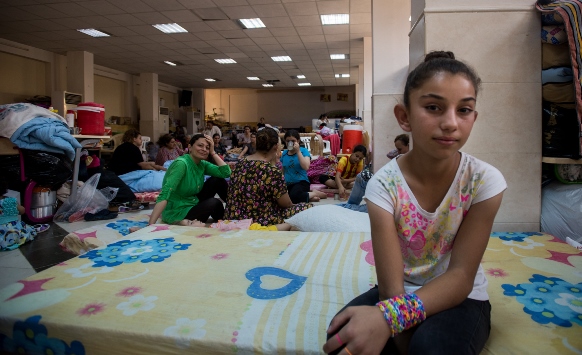Using AI to control energy for indoor agriculture
30 September 2024
Published online 7 September 2014
Conflicts in the region are robbing children of education, healthcare, sanctuary, innocence and peace of mind, and this dark legacy will most likely span generations.

In this series Nature Middle East explores the obvious and hidden effects of war on some of the most vulnerable members of the population: children and young adults.
Wars harm the psyche and mental health of children, as psychosocial distress is becomes not just common, but a blanket condition, according to Marta Passerini, Save the Children’s child protection technical advisor in Lebanon.
International organizations provide regular one-on-one counselling only for acute cases, but they can’t reach everyone. Their projects are mainly focused on capacity building, training of professionals and creating support groups.
Resources and manpower dedicated to mental health programmes in particular are often dwarfed by the size of the problem. In some camps, affected young people are “now adrift in a culture where they are dependent on aid works for basic necessities,” says a 2013 report by UNICEF and the International Medical Corps.
“When you look at [Syrian] children now, you’ll see fear, symbols, flags and political slogans – ideas blemished by war. You will not see the innocent dream of a child,” says Konstantina Bougonikolou, psychologist and medical coordinator with Doctors Without Borders.
These psychological scars will remain. But some children caught in war zones, don’t live long enough to even experience distress or get a chance recover from it.
In Syria, many children are dying in rundown healthcare facilities, either treated by volunteers who receive minimal training or overworked medical staff. Vaccine programmes are collapsing and preventable diseases, like measles and polio, are emerging again, while premature deaths are increasing.
When you look at [Syrian] children now, you’ll see fear, symbols, flags and political slogans – ideas blemished by war. You will not see the innocent dream of a child.
A Save the Children report on the impact of three years of war on the health of Syria’s children, reads: “Across Syria, 60% of hospitals and 38% of primary health facilities have been damaged or destroyed, and production of drugs has fallen by 70%. Nearly half of Syria’s doctors have fled the country: in Aleppo, a city which had 2,500 doctors, only 36 remain.”
Squalid living conditions and poor water and sanitation, coupled with frequent displacement, led to the increase of skin diseases. Cases of leishmaniasis, a parasitic disease that affects several internal organs, and can lead to permanent disfiguration –increased from 3,000 to 100,000 within three years.
The situation is mirrored in Iraq, where years of instability have weakened the country’s infrastructure and its capacity to care for its most vulnerable.
As well as the crumbling healthcare system, schools are becoming make-shift housing camps, and exams are being cancelled or pushed back to tentative dates. Hospitals are attacked or forced to evacuate during conflict as populations are displaced with the resurgence of violence, and take-overs by militants of the Islamic State.
Like everyone else, healthcare providers are fleeing for their lives, and education is now a luxury.
In Syria, children are dropping out of schools, boys have become cheap labour, and girls are often too afraid to walk to schools alone. One bright spot is a programme in a number refugee camps in Kurdish territories and in Turkey, where children are given access to regular schooling.
Some countries hosting the camps are trying to help. In Jordan and Lebanon, schools are offering extra shifts for refugees of school-age, and the governments are collaborating with international aid organizations. In Egypt, public schools have created spaces for more than half of school-age refugee children. But the extent of war and devastation means it is often not enough.
Between broken healthcare systems in affected countries, trauma and depression among child refugees, with people as young as 12 leaving schools to primary become caretakers of households, the picture is bleak.
How fear has stolen the childhood of a generation
Iraqi children endure a crippled healthcare system
The toll of war on learning for a generation
Syria's crumbling healthcare system
Once proud, Iraq's education system reels from decades of setbacks
First polio case confirmed in Iraq
Depleted medical staff in Syria struggling to save lives
doi:10.1038/nmiddleeast.2014.216
Stay connected: